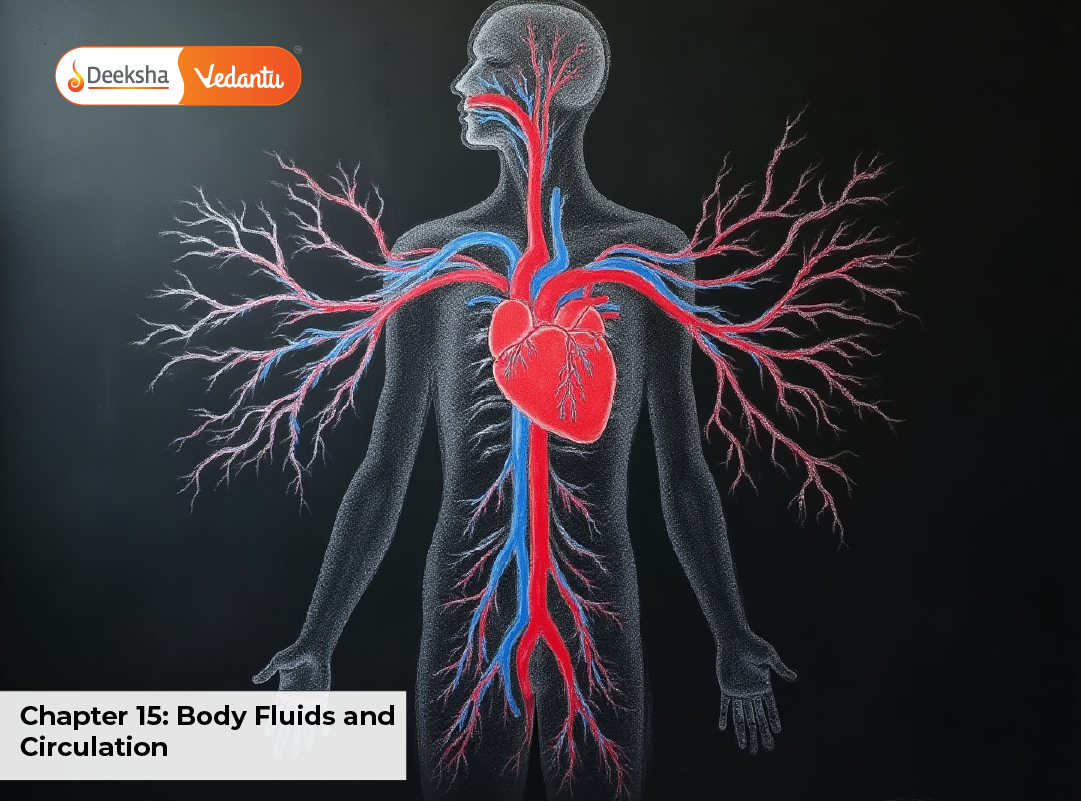Understanding how nutrients, gases, and wastes are transported in our body is crucial for mastering NEET Biology. Chapter 15: Body Fluids and Circulation explains the complex circulatory system of humans, focusing on blood, lymph, the heart, double circulation, ECG, and more.
Let’s dive into this chapter, breaking it down with NEET-focused highlights, molecular explanations, concept tables, and exam pointers.
What are Body Fluids?
Body fluids are the liquids in our body that help in the transport of substances. The two primary body fluids in humans are:
- Blood
- Lymph (Tissue fluid)
These fluids are responsible for transporting oxygen, nutrients, hormones, and waste products.
Blood: Composition and Functions
Components of Blood
| Component | Percentage | Function |
| Plasma | ~55% | Transport of nutrients, hormones, etc. |
| Formed elements | ~45% | Includes RBCs, WBCs, and Platelets |
1. Plasma
- Straw-colored fluid
- Contains water (~90-92%), proteins (~7%), and other solutes
- Proteins include fibrinogen, globulin, and albumin
2. Red Blood Cells (Erythrocytes)
- Biconcave, no nucleus
- Contain hemoglobin for oxygen transport
- Life span: ~120 days
3. White Blood Cells (Leukocytes)
| Type | Function |
| Neutrophils | Phagocytosis (engulf bacteria) |
| Lymphocytes | Antibody production |
| Monocytes | Macrophages |
| Eosinophils | Allergic reactions |
| Basophils | Secrete histamine |
4. Platelets (Thrombocytes)
- Cell fragments
- Help in blood clotting
Blood Groups and Rh Factor
ABO Blood Group System
- Discovered by Karl Landsteiner
- Based on antigen (A/B) presence on RBCs and corresponding antibodies in plasma
| Blood Group | Antigen | Antibody | Can Donate To | Can Receive From |
| A | A | anti-B | A, AB | A, O |
| B | B | anti-A | B, AB | B, O |
| AB | A and B | None | AB | All (Universal Recipient) |
| O | None | anti-A, anti-B | All (Universal Donor) | O |
Rh Factor
- Rh+ has Rh antigen, Rh– does not
- Erythroblastosis fetalis can occur in Rh– mothers with Rh+ fetus
Coagulation of Blood
- Clotting factors: Fibrinogen → Fibrin via Thrombin
- Calcium ions and Vitamin K are essential
- Platelets release thromboplastin → triggers clotting
Lymph (Tissue Fluid)
- Formed by filtration of blood plasma into interstitial spaces
- Lymphatic capillaries collect it and return to the bloodstream
- Helps in:
- Fat transport
- Immunity
- Fluid balance
Human Circulatory System
Humans have a closed double circulatory system with a four-chambered heart.
Structure of Human Heart
- Four Chambers:
- Right Atrium (RA)
- Right Ventricle (RV)
- Left Atrium (LA)
- Left Ventricle (LV)
- Valves: Prevent backflow
- Tricuspid – between RA & RV
- Bicuspid/Mitral – between LA & LV
- Semilunar – in pulmonary and aortic arteries
Circulation Pathways
1. Pulmonary Circulation
- RA → RV → Pulmonary Artery → Lungs → Pulmonary Vein → LA
2. Systemic Circulation
- LV → Aorta → Body Organs → Vena Cava → RA
3. Coronary Circulation
- Blood supply to heart muscles via coronary arteries
Table: Types of Circulation
| Type | Involves |
| Pulmonary | Heart ↔ Lungs |
| Systemic | Heart ↔ Body tissues |
| Coronary | Aorta ↔ Heart muscles |
| Hepatic portal | Digestive tract ↔ Liver |
Cardiac Cycle
- Duration: ~0.8 seconds
- Phases:
- Atrial systole
- Ventricular systole
- Joint diastole
Heart Sounds
- LUB: Closure of AV valves (beginning of ventricular systole)
- DUB: Closure of semilunar valves (beginning of diastole)
ECG (Electrocardiogram)
- Records electrical activity of heart
- Waves:
- P wave: Atrial depolarization
- QRS complex: Ventricular depolarization
- T wave: Ventricular repolarization
Cardiac Output and Heart Rate
- Heart Rate: ~72 beats/min
- Stroke Volume: ~70 mL
- Cardiac Output = Stroke Volume × Heart Rate = ~5000 mL/min
Regulation of Cardiac Activity
- Myogenic Heart: Initiates its own impulse via SA node
- Controlled by:
- Medulla oblongata (autonomic nervous system)
- Hormones like adrenaline
Disorders of Circulatory System
| Disorder | Description |
| Hypertension | High BP >140/90 mmHg |
| Coronary Artery Disease (CAD) | Blockage of arteries supplying the heart |
| Angina | Chest pain due to reduced blood flow |
| Heart Failure | Inability to pump blood effectively |
| Atherosclerosis | Hardening of arteries due to plaques |
NEET Question Examples
MCQ 1:
Which chamber of the heart receives oxygenated blood from the lungs?
A. RA
B. LA
C. RV
D. LV
Answer: B. Left Atrium
MCQ 2:
The universal donor blood group is:
A. A
B. AB
C. B
D. O
Answer: D. O
MCQ 3:
ECG T-wave represents:
A. Atrial systole
B. Ventricular repolarization
C. Ventricular systole
D. Atrial repolarization
Answer: B. Ventricular repolarization
Frequently Asked Questions (FAQs)
What are the components of blood important for NEET?
Plasma, RBCs, WBCs (especially neutrophils and lymphocytes), and platelets. Focus on hemoglobin and clotting factors.
Why is double circulation important in humans?
It separates oxygenated and deoxygenated blood, ensuring efficient oxygen delivery to tissues.
What is the significance of ECG in NEET syllabus?
Understanding P, QRS, and T waves is essential for diagnosing cardiac health and is often asked in NEET exams.
How does lymph differ from blood?
Lymph lacks RBCs, has fewer proteins, and helps in fat absorption and immune responses.
What regulates heartbeat?
The SA node (pacemaker), controlled by the autonomic nervous system and hormones like adrenaline.
Conclusion
Chapter 15: Body Fluids and Circulation provides a comprehensive understanding of how our body maintains transport and balance of materials. It lays the foundation for complex concepts like ECG interpretation, heart disorders, and blood group compatibility – all of which are heavily tested in NEET.
Stay focused on:
- Conceptual clarity on circulation pathways
- Diagrams of the heart and ECG
- Blood group logic and Rh factor
- Functions of each component in blood and lymph
For NEET 2025, ensure you solve multiple previous year MCQs based on this chapter and revise diagrams and terminologies regularly.




Get Social